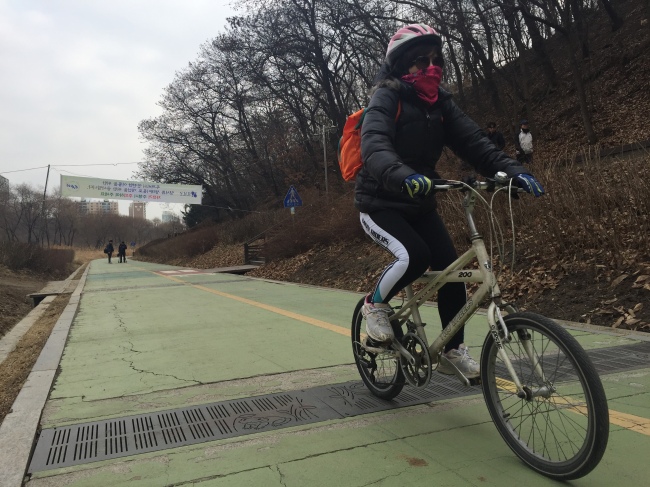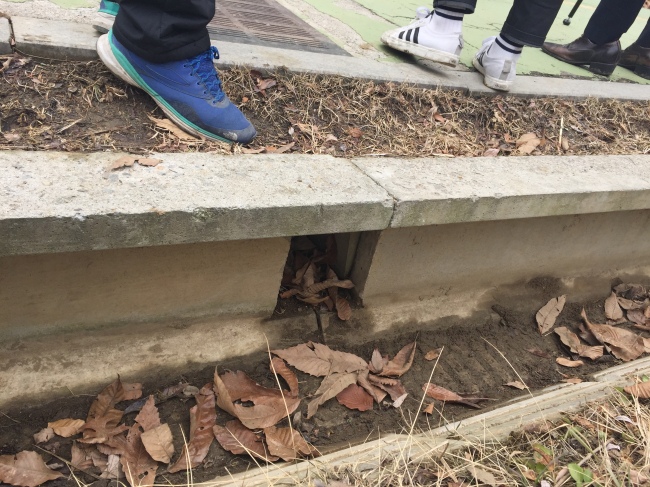More leisure facilities are being built near rivers and streams these days and while this benefits urban dwellers, another party is being exposed to higher risks — more amphibians are being killed by cyclists and pedestrians, raising ecological concerns about their well-being.
 |
| A bicyclist passes over the ecological corridor installed under a bike road at Yangjaecheon Stream in southern Seoul. (Lee Hyun-jeong/The Korea Herald) |
According to Chung-Ang University’s Green River Research Center, a large number of toads are killed every year in Yangjaecheon Stream in southern Seoul, especially near the paddy field.
In the 1,400-square-meter rice paddy near Yanjaecheon Stream, about 3,000 to 4,000 toads breed every year.
However, this number has dropped sharply, mainly due to the bike and pedestrian roads that have been constructed between the paddy field and the adjacent hill.
Toads are official “indicator species” and their numbers can show the level of ecological risk and climate change.
Residing usually near wetlands, toads look for water bodies in early March during breeding season. Grown-up toads soon return to nearby hills in April and May whereas baby toads find homes on their own in October.
Roadkill happens the most during the moving season in spring and October, researchers said.
“Although the exact number is difficult to count, only about 20 percent of the toads succeeded in returning to their home after breeding in the paddy fields. The rest are killed because of many reasons such as by bikes, pedestrians or ducks,” said environmental and plant engineering professor Kim Jin-hong who headed the research team.
The paddy field in the middle of the stream was built two decades ago for children’s ecology courses on rice farming. However, it also became a breeding site for toads living in the adjacent hill.
In order to secure the travel route and safety of toads, Gangnam-gu Office installed 20 ecological corridors under the bike and pedestrian roads in 2013, along with a 204-meter-long guard fence to better lead them to use the corridors.
Through monitoring the movement of toads with a camera for the past year, the research team found that many toads were still exposed to the risk of becoming roadkill as they did not use the ecological corridors effectively.
“Toads were still moving through the bike and pedestrian roads instead of the corridors. Many bicyclists and pedestrians do not notice them as toads usually move at night. The dead toads are also often removed quickly by ducks or other birds,” said Yoon Deok-soo, the president of civic group People for Protecting Yangjaecheon Stream.
Entrances to the ecological corridor had also previously been challenging for toads to use, he added. The amphibians had to climb up a slight step to enter the corridor, which would have been tough for baby toads.
As part of efforts to better guide amphibian animals to move through the safe corridors, the district office independently installed a new ecological corridor that is wider by twofold than the original ones and without the small step.
The research team said it would continue to monitor the effectiveness of the new corridor.
Yangjeachoen Stream is not the only habitat in the capital for amphibious species.
 |
| A man walks over the ecological corridor on a pedestrian pathway at Yangjaecheon Stream in southern Seoul. (Lee Hyun-jeong/The Korea Herald) |
Gangseo-gu in western Seoul is the only district in the capital where three legally protected amphibian species reside. They are the narrow-mouthed toad, the Korean golden frog and Suweon tree frog. The Gangseo Wetland in a public park near the Hangang River is the largest home for narrow-mouthed toads in the city.
Like other amphibians, narrow-mouthed toads gather and reproduce in water bodies in summer and move back to dry areas for hibernation in October.
Amphibians that have become roadkill are most spotted around late May when they move to water bodies, and in September and October when they return to dry areas, environmentalists said.
According to environment group Mulpure Ecoeducation Center’s monitoring report, 500,000 out of 850,000 narrow-mouthed toads were killed on a 100-meter bike road in the park between 2011 and 2012.
The deaths have declined over the past few years as sufficient rainfall allowed the species to move faster.
But ecological corridors are still essential for the species, experts said.
“The fact that there are no ecological corridors under the bike roads show that the city did not consider the importance of ecological factors when constructing infrastructures for humans,” said MEC’s coordinator Park Jae-seon.
With the public increasingly calling for the conservation of narrow-mouth toads, the Seoul Metropolitan Government on Monday decided to build ecological corridors at the wetland.
“(The city) asked the MEC for recommendations for corridor-needed spots at the wetland. The installment will be finished no later than May, considering the moving season of the amphibian animals,” said a city official.
Seoul City, however, has no further plans to install ecological corridors along the side of the Hangang River. At the river, which is an important habitat for many species, bike roads measuring 70 kilometers in total, have been installed and none of them have ecological corridors.
Seoul City is not the only municipality with a lack of ecological corridors.
According to the Environment Ministry, only 17 ecological corridors have been installed across the country as of this year, with none of them in Seoul.
Yangjaecheon Stream’s ecological corridor is not counted, a ministry official said.
“The number does not reflect all corridors installed as the ministry only counts those reported by the cities. At least more than 17 corridors are estimated to have been installed in the country,” said a ministry official in charge of managing the ecological corridors.
The government should come up with comprehensive measures to protect species which live near the bike roads as more cities gear up to build roads that cater to human needs, experts said.
“There is a need for the government to check the ecological conditions of areas first whenever it plans to construct bike or pedestrian roads at rivers and streams, and come up with measures on how to maintain ecological conditions for animal species. So far, there is no consideration for species at all,” professor Kim Jin-hong said.
By Lee Hyun-jeong (rene@heraldcorp.com)

